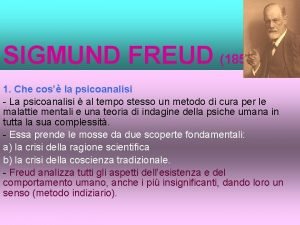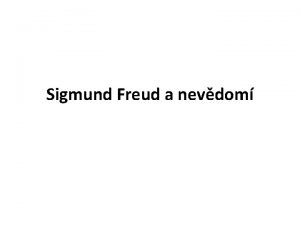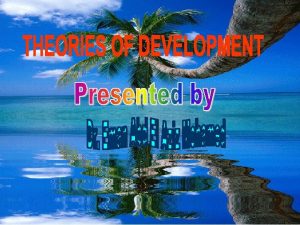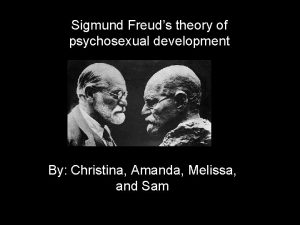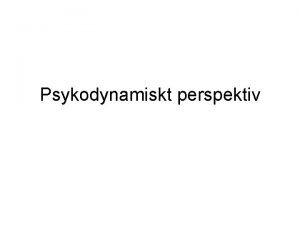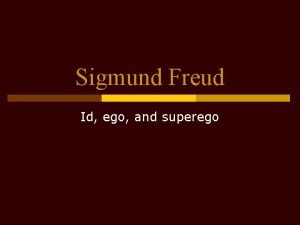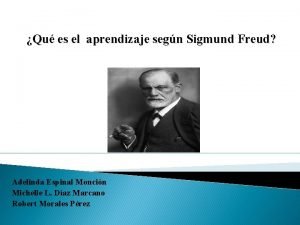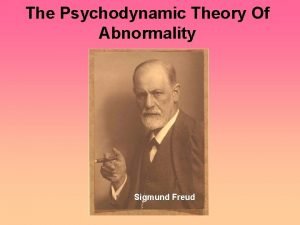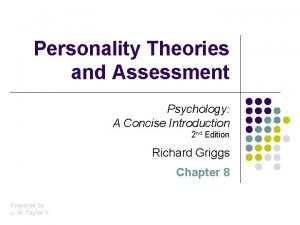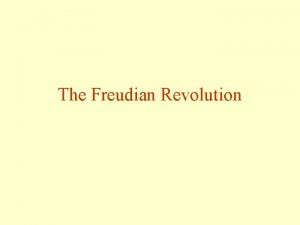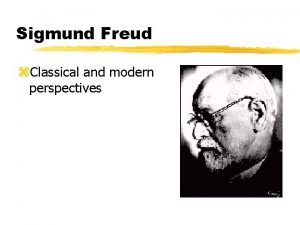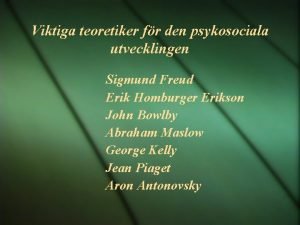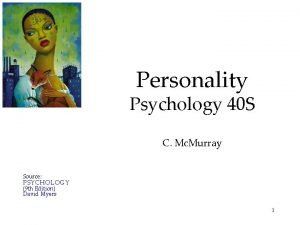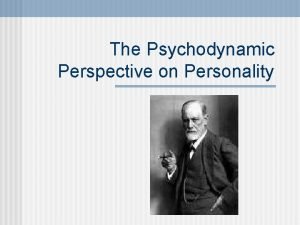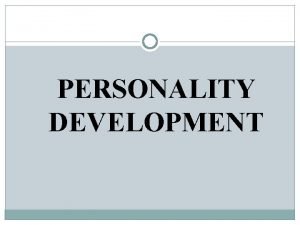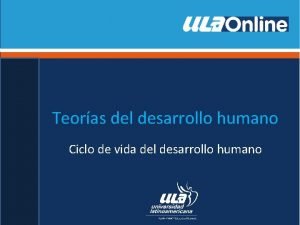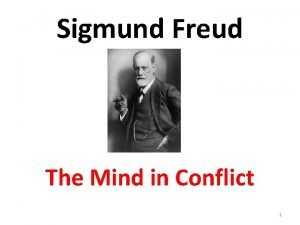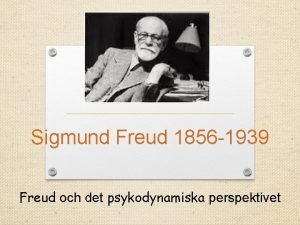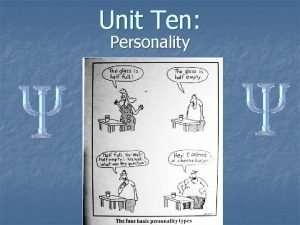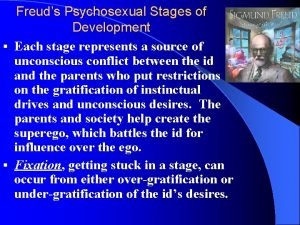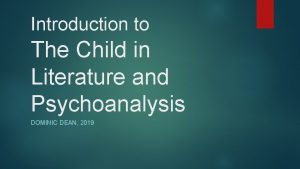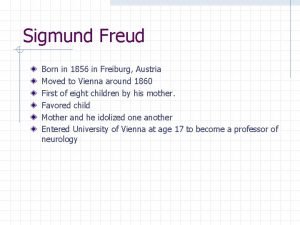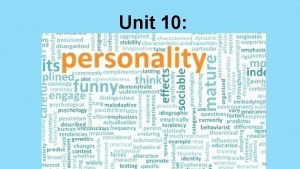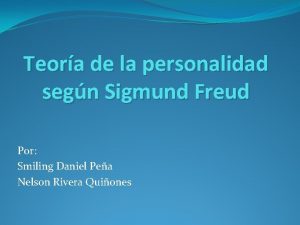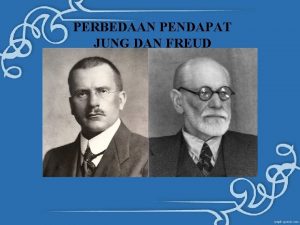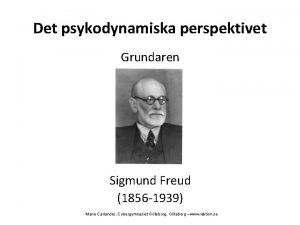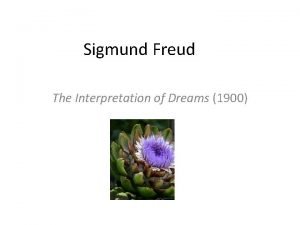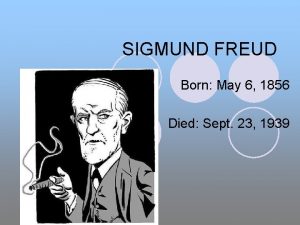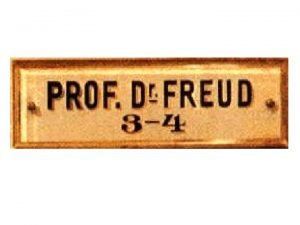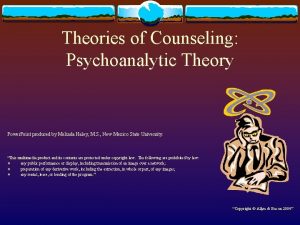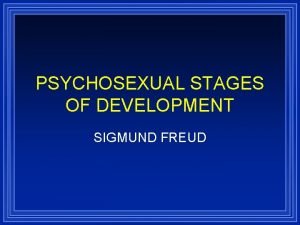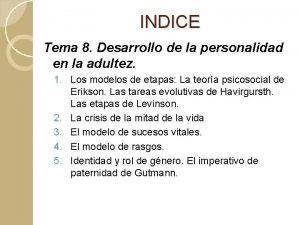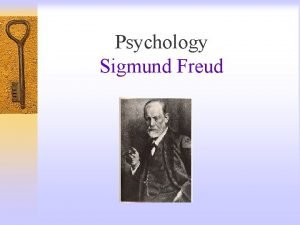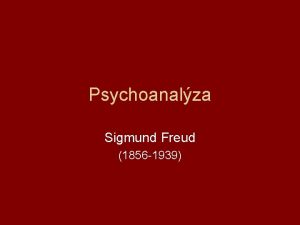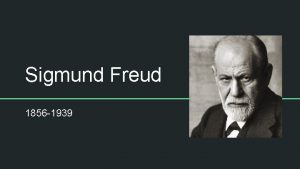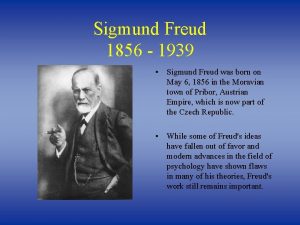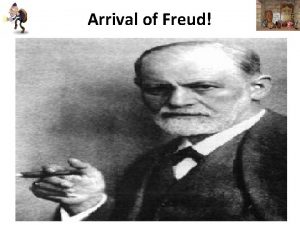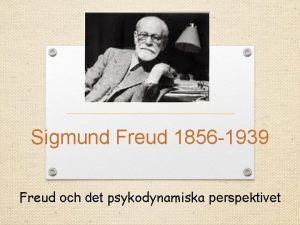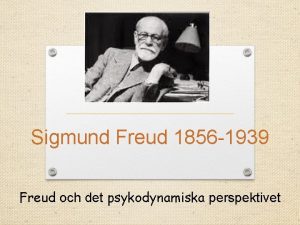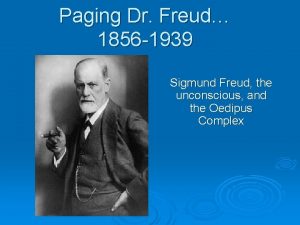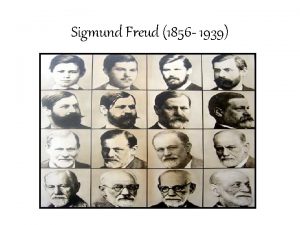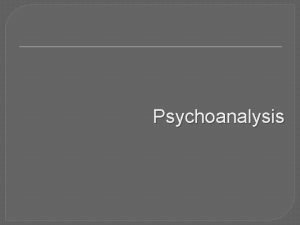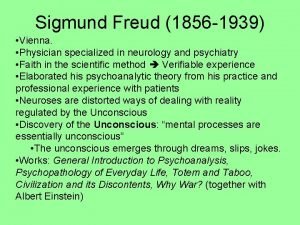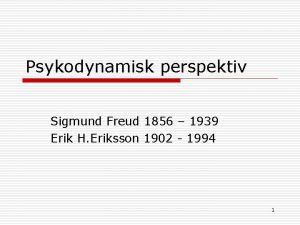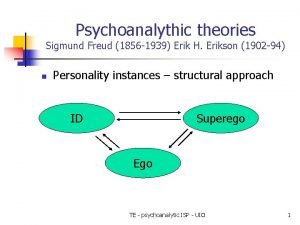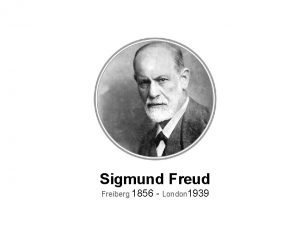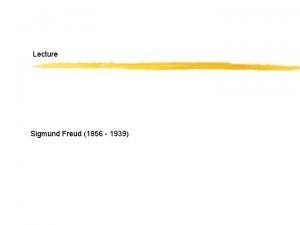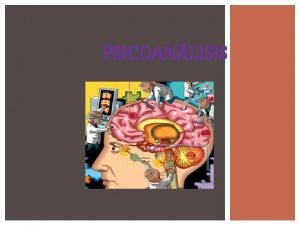SIGMUND FREUD 1856 1939 Sigmund Freud was a




![PSYCHOANALYSIS/ PERSONALITY THEORY • Freud believed that your psyche [mind] has two parts: • PSYCHOANALYSIS/ PERSONALITY THEORY • Freud believed that your psyche [mind] has two parts: •](https://slidetodoc.com/presentation_image_h2/5512956b5c70db6b6c3dfe31a6472684/image-5.jpg)







































- Slides: 44

SIGMUND FREUD 1856 -1939 .

Sigmund Freud was a very controversial personality theorist, and was an Austrian physician.

FREUD’S PSYCHOANALYTIC PERSPECTIVE “I was the only worker in a new field. ” Love him or hate him, Sigmund Freud has profoundly influenced Western culture. To recognize his influence, we need to understand Freud’s ideas concerning the unconscious, dream interpretation, and mechanisms for defending against anxiety.

THREE FREUDIAN TOPICS USEFUL IN LITERARY ANALYSIS 1. Psychoanalysis/Personality Theory • Psyche: • Conscious and Unconscious Mind • Id/Ego/Superego • Psychoanalysis Purpose/Techniques 2. Defense Mechanisms 3. Freudian Slips
![PSYCHOANALYSIS PERSONALITY THEORY Freud believed that your psyche mind has two parts PSYCHOANALYSIS/ PERSONALITY THEORY • Freud believed that your psyche [mind] has two parts: •](https://slidetodoc.com/presentation_image_h2/5512956b5c70db6b6c3dfe31a6472684/image-5.jpg)
PSYCHOANALYSIS/ PERSONALITY THEORY • Freud believed that your psyche [mind] has two parts: • • Unconscious Mind: large below-the-surface reservoir which contains thoughts, wishes, feelings and memories, of which we are unaware. Not ‘subconscious!’ Conscious Mind: The part of your mind that your thoughts make you aware of

FREUD ON THE ‘SUBCONSCIOUS’ • "If someone talks of subconsciousness, I cannot tell whether he means the term topographically – to indicate something lying in the mind beneath consciousness – or qualitatively – to indicate another consciousness, a subterranean one, as it were. He is probably not clear about any of it. The only trustworthy antithesis is between conscious and unconscious. "


THE PSYCHE: THE MIND, AND WHY WE DO WHAT WE DO • People’s actions can be explained by the interaction of the three parts of their unconscious mind: • The Id • The Ego • The Superego


THE ID: BASIC DESIRE Id-a reservoir of unconscious psychic energy constantly striving to satisfy basic drives to survive, reproduce, and aggress. The id operates on the pleasure principle: If not constrained by reality, it seeks immediate gratification. • What each person desires • No sense of conscience: everyone’s “inner child” • Children, before they are taught social skills • Demands immediate gratification of their needs and desires • Raw, basic, primal

SUPEREGO: GUILT • Superego-represents internalized ideals and provides standards for judgment (the conscious) and for future aspirations. • Guided by socially imposed behavior and a sense of guilt • Learned through adult instruction and living in society • Parents scold you and other members of society criticize or teach you

THE EGO: REALITY Ego-the largely conscious, “executive” part of personality that, according to Freud, mediates the demands of the id, superego, and reality. The ego operates on the reality principle, satisfying the id’s desires in ways that will realistically bring pleasure rather than pain. • The balance between the Id and the Superego • Takes the desires of the Id, filters them through the superego, and comes up with an action that satisfies both entities • The Ego realizes that the Id must be satisfied, but that there are certain socially acceptable ways to achieve satisfaction


THREE FREUDIAN TOPICS USEFUL IN LITERARY ANALYSIS 1. Psychoanalysis/ Personality Theory • Psyche: • Conscious and Unconscious Mind • Id/Ego/Superego • Psychoanalysis Techniques 2. Defense Mechanisms 3. Freudian Slips

PSYCHOANALYSIS/ PERSONALITY THEORY: METHODS OF PSYCHOANALYSIS: ASSESSING THE UNCONSCIOUS • Free Association: the patient is asked to relax and say whatever comes to mind, no matter how embarrassing or trivial. • Thematic Apperception Test: a test in which people view ambiguous pictures and then make up stories. • Rorschach Inkblot Test: a set of 10 inkblots, seeks to identify people’s inner feelings by analyzing their interpretations of the inkblots. • Dream Analysis: The subject of dreams provides a link to the unconscious mind …

PSYCHOANALYSIS/ PERSONALITY THEORY: METHODS OF PSYCHOANALYSIS: ASSESSING THE UNCONSCIOUS • Free Association: the patient is asked to relax and say whatever comes to mind, no matter how embarrassing or trivial. • Thematic Apperception Test: a test in which people view ambiguous pictures and then make up stories.

THEMATIC APPERCEPTION TEST

THEMATIC APPERCEPTION TEST

PSYCHOANALYSIS/ PERSONALITY THEORY: METHODS OF PSYCHOANALYSIS: ASSESSING THE UNCONSCIOUS • Free Association: the patient is asked to relax and say whatever comes to mind, no matter how embarrassing or trivial. • Thematic Apperception Test: a test in which people view ambiguous pictures and then make up stories. • Rorschach Inkblot Test: a set of 10 inkblots, seeks to identify people’s inner feelings by analyzing their interpretations of the inkblots.

RORSCHACH INKBLOT TEST

RORSCHACH INKBLOT TEST

RORSCHACH INKBLOT TEST

RORSCHACH INKBLOT TEST

PSYCHOANALYSIS/ PERSONALITY THEORY: METHODS OF PSYCHOANALYSIS: ASSESSING THE UNCONSCIOUS • Free Association: the patient is asked to relax and say whatever comes to mind, no matter how embarrassing or trivial. • Thematic Apperception Test: a test in which people view ambiguous pictures and then make up stories. • Rorschach Inkblot Test: a set of 10 inkblots, seeks to identify people’s inner feelings by analyzing their interpretations of the inkblots. • Dream Analysis: The subject of dreams provides a link to the unconscious mind …

DREAM ANALYSIS According to Freud, dreams are the “royal road to the unconscious. ” Dreams have: Manifest Content: the storyline of our dreams dreamers are conscious of; sometimes incorporates traces of previous days’ experiences and preoccupations. Latent Content: censored symbolic version; consists of unconscious drives and wishes that may be threatening if expressed directly.

DREAM ANALYSIS PRACTICE: DREAMS ABOUT LOSING TEETH • Dreaming about losing your teeth is an indicator of anxiety and, possibly, depressive states. Dreams about losing teeth also tend to point to feelings of helplessness and lack of control over one’s life circumstances. • The loss of a tooth or teeth in your dream could be a way to symbolically bring to your awareness something you are giving up or feel like you are losing in your waking life. • A dream of losing teeth could be a reminder that you either made a decision or are about to make one that feels like a heavy compromise and could generate emotional suffering if not dealt with it consciously. You may be facing a situation where you have to make costly compromises and the trade-off is not satisfying.

DREAM ANALYSIS VARIES BY CULTURE & ERA • Until the end of the 20 th century, it was common to interpret losing teeth in dreams as a sign of the future death of a family member. This meaning associated with the loss of a tooth or teeth in a dream is held in various traditions, including traditional Chinese and some native American dream interpretations. • More recently, a more symbolic interpretation is preferred to present losing teeth in dreams as a representation of the dreamer’s fear of aging.

FOUR FREUDIAN TOPICS USEFUL IN LITERARY ANALYSIS 1. Psychoanalysis/ Personality Theory • Psyche: • Conscious and Unconscious Mind • Id/Ego/Superego • Psychoanalysis Purpose/Techniques 2. Defense Mechanisms 3. Freudian Slips

DEFENSE MECHANISMS 1. Repression UNCONSCIOUS TACTICS THAT REDUCE OR REDIRECT ANXIETY IN VARIOUS WAYS, BUT ALWAYS BY DISTORTING REALITY. • banishes anxiety-arousing thoughts and feelings from consciousness 2. Regression • retreating to an earlier, more infantile stage of development 3. Projection • Attributing one’s own unacceptable threatening impulses to others 4. Rationalization 5. Displacement • offers self-justifying explanations in place of the real, more threatening, unconscious reasons for one’s actions • shifts impulses toward a more acceptable or less threatening object or person, as when redirecting anger toward a safer outlet

DEFENSE MECHANISMS UNCONSCIOUS TACTICS THAT REDUCE OR REDIRECT ANXIETY IN VARIOUS WAYS, BUT ALWAYS BY DISTORTING REALITY. • Repression: banishes anxiety-arousing thoughts and feelings from consciousness

DEFENSE MECHANISMS UNCONSCIOUS TACTICS THAT REDUCE OR REDIRECT ANXIETY IN VARIOUS WAYS, BUT ALWAYS BY DISTORTING REALITY. • Regression: retreating to an earlier, more infantile stage of development

DEFENSE MECHANISMS UNCONSCIOUS TACTICS THAT REDUCE OR REDIRECT ANXIETY IN VARIOUS WAYS, BUT ALWAYS BY DISTORTING REALITY. • Projection: Attributing one’s own unacceptable threatening impulses to others

DEFENSE MECHANISMS UNCONSCIOUS TACTICS THAT REDUCE OR REDIRECT ANXIETY IN VARIOUS WAYS, BUT ALWAYS BY DISTORTING REALITY. • Rationalization: offers self-justifying explanations in place of the real, more threatening, unconscious reasons for one’s actions

DEFENSE MECHANISMS UNCONSCIOUS TACTICS THAT REDUCE OR REDIRECT ANXIETY IN VARIOUS WAYS, BUT ALWAYS BY DISTORTING REALITY. • Displacement: shifts impulses toward a more acceptable or less threatening object or person, as when redirecting anger toward a safer outlet


FREUDIAN SLIPS • A Freudian slip, also called parapraxis, is an error in speech, memory, or physical action that is interpreted as occurring due to the interference of some unconscious ("dynamically repressed"), subdued, wish, conflict, or train of thought. • “Where you say one thing but you mean your mother. ”

EXAMPLES • In Disney's Atlantis: The Lost Empire, Milo has a line: "I know how to swim pretty girl—good! Pretty good, I swim pretty good. "

EXAMPLES • "One of my patients had a rather amusing Freudian slip: he was having dinner with his wife, and he meant to say "pass the salt", but instead he said "You've ruined my life, you blood-sucking shrew. ' "— Niles Crane, Frasier

VIDEO EXAMPLE • How does this classic sitcom moment illustrate the unconscious mind’s operation? http: //www. youtube. com/watch? v=b. Toi. Iihknvs

FREUD AND LITERATURE So what does all of this psychological business have to do with literature and the study of literature? • Put simply, some critics believe that we can ". . . read [texts] psychoanalytically. . . to see which concepts are operating in the text in such a way as to enrich our understanding of the work and, if we plan to write a paper about it, to yield a meaningful, coherent psychoanalytic interpretation" (Tyson 29).

TYPICAL QUESTIONS ASKED DURING FREUDIAN ANALYSIS OF A LITERARY TEXT: • What does the work suggest about the psychological being of its author? • What might a given interpretation of a literary work suggest about the psychological motives of the reader? • Are there any oedipal dynamics - or any other family dynamics - at work here? • How can characters' behavior, narrative events, and/or images be explained in terms of psychoanalytic concepts of any kind (for example. . . fear or fascination with death, character’s actions reflecting the operations of the ego or id or superego)? • Are there prominent words in the piece that could have different or hidden meanings? Could there be a subconscious reason for the author using these “problem words? ”

CH 4 REVIEW • “You could have had everyone when the shelters were finished. But you had to hunt—” • “We needed meat. ” • Jack stood up as he said this, the bloodied knife in his hand. The two boys faced each other. There was the brilliant world of hunting, tactics, fierce exhilaration, skill; and there was the world of longing and baffled common sense. Jack transferred the knife to his left hand smudged blood over his forehead as he pushed down the plastered hair. (65) What is the new crisis between Jack and Ralph? Why is the person with common sense often “baffled” (confused and prevented from using it effectively)? How is Jack changing as a character?

APPLY YOUR KNOWLEDGE DISCUSSION QUESTION • Describe a time when a character in LOTF used each of the five defense mechanisms Freud identified. • Work alone or in groups of 2 (no groups of 3). • Turn in tomorrow at the end of class.

FREUD REVIEW QUESTIONS • List the four techniques of psychoanalysis. • Evaluate which would be the most effective in your opinion. Justify your answer.
 Gmund freud
Gmund freud Erikson stage
Erikson stage Freud ledovec
Freud ledovec Sigmund freud mother theory
Sigmund freud mother theory The psychosexual theory was popularized by
The psychosexual theory was popularized by Oedipus complex and electra complex
Oedipus complex and electra complex Försvarsmekanismer vid kris
Försvarsmekanismer vid kris Ego vs superego
Ego vs superego Imagenes del psicoanalisis de sigmund freud
Imagenes del psicoanalisis de sigmund freud Sigmund freud iceberg
Sigmund freud iceberg Sigmund freud psychosexual stages
Sigmund freud psychosexual stages Humanistic approach abraham maslow
Humanistic approach abraham maslow Eros freud
Eros freud What is freudian revolution
What is freudian revolution Freud conclusion
Freud conclusion Freud unconscious mind
Freud unconscious mind Superego holds
Superego holds Realitetsprincipen
Realitetsprincipen Psychosexual stages
Psychosexual stages Etapas psicosexuales de freud
Etapas psicosexuales de freud Sigmund freud creative writers and daydreaming
Sigmund freud creative writers and daydreaming Reaction formation psychology
Reaction formation psychology Freud vs jung
Freud vs jung Defense mechanism examples
Defense mechanism examples Freud's personality theory
Freud's personality theory Teoria de freud
Teoria de freud Freud
Freud Freuds utvecklingsteori
Freuds utvecklingsteori Perkembangan kepribadian menurut sigmund freud
Perkembangan kepribadian menurut sigmund freud Castration
Castration Phallic fixation
Phallic fixation Sigmund freud family tree
Sigmund freud family tree Sigmund freud nationality
Sigmund freud nationality Freud clark university
Freud clark university Psychoanalytic theory
Psychoanalytic theory Yo superyo ello
Yo superyo ello Perbedaan teori kepribadian freud dan jung
Perbedaan teori kepribadian freud dan jung El ello el yo y el superyo explicacion
El ello el yo y el superyo explicacion Personlighetens uppbyggnad
Personlighetens uppbyggnad The interpretation of dreams 1900
The interpretation of dreams 1900 Sigmund freud birth
Sigmund freud birth 6 may 1856
6 may 1856 Psychoanalysis
Psychoanalysis Erogenous zone of phallic stage
Erogenous zone of phallic stage Teoria psicosexual de freud
Teoria psicosexual de freud
